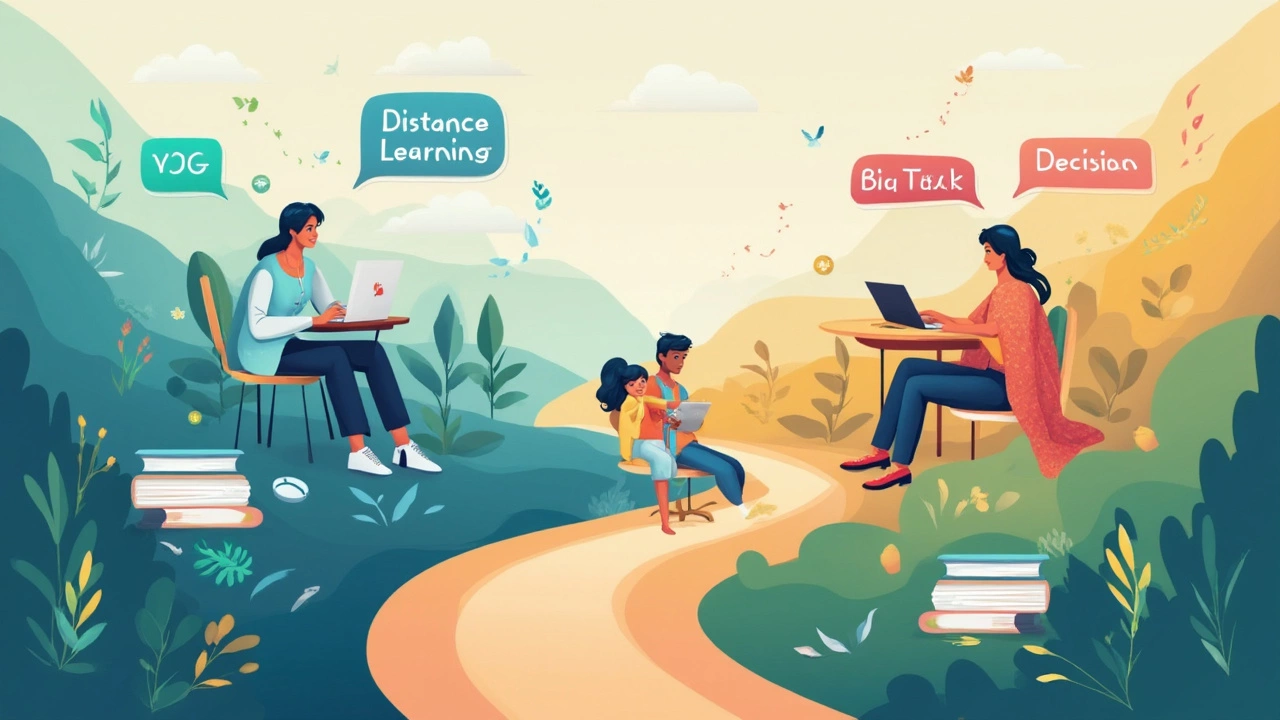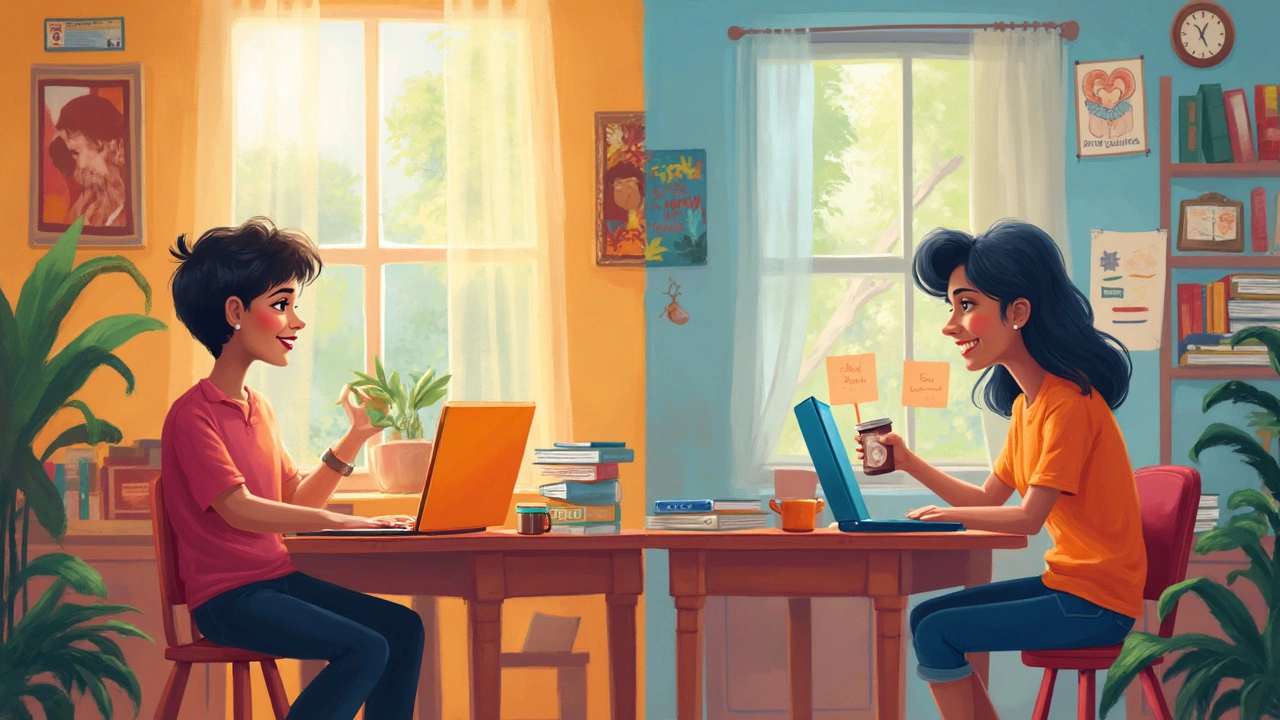Everyone’s got an opinion on learning at home versus learning in the classroom—but most skip the stuff that actually matters to your day-to-day life. Think about it: Do you want to wake up, wear pajama pants, and hit ‘join meeting’? Or do you find it easier to stay focused when a teacher’s right in front of you, reading your face?
The big truth? Both styles come with perks and pitfalls. The old argument that classroom beats online in every way isn’t really true anymore, especially with the tech we’ve got in 2025. But those promo videos showing everyone smiling on a Zoom call? That’s not always the reality either.
What actually matters is how you learn best—not what’s trending. The right fit could mean the difference between coasting along and actually loving what you’re learning. Ready to figure out which one fits you? Let’s sort it out with facts, not just opinions.
- How Distance Learning Works Day-to-Day
- The Classroom: Does Old School Mean Old-Fashioned?
- Who Wins Where? Surprising Science & Real-Life Stories
- Tips to Help You Pick (and Make the Most of Either)
How Distance Learning Works Day-to-Day
Distance learning looks way different than it did even five years ago. Now it’s not just boring recorded lectures and endless PDFs. Instead, you’ll probably use a mix of live video calls, interactive assignments, group chats, and online quizzes. Most platforms—think Canvas, Google Classroom, or Microsoft Teams—put all your lessons, study materials, and deadlines in one spot. If you hate searching emails for homework, this change alone can be life-saving.
You set your schedule, which feels awesome if you’re working or juggling family stuff. Most classes are “asynchronous.” This means you can log in anytime to check notes, watch lectures, or post in discussion groups. Bigger assignments usually have due dates, but how and when you get there is kind of up to you. Some courses do have set meeting times (they’ll call them “synchronous”), so you’ll need a calendar reminder.
Worried about feedback or getting lost? There are usually discussion forums and built-in chat tools so you can ask questions—sometimes 24/7, and your classmates might answer before the instructor does. Tech glitches still happen, but schools now offer much faster IT help than back in 2020.
Here’s what a typical week might look like:
- Check the online portal for announcements, assignments, and test dates every Monday.
- Watch short lesson videos on your own time—could be 10 minutes here, 20 minutes there.
- Drop a comment in a class forum or group discussion. (Usually required, so don’t skip it!)
- Complete a quiz or worksheet by Friday night, not midnight—for once, teachers have learned students hate that.
- Email or video chat with your instructor if you get stuck.
Some people think distance learning is lonely, but group projects and breakout rooms pop up all the time. You might even work more closely with classmates than you would in a lecture hall, thanks to apps like Slack or Discord. Fast fact: A recent survey by the Online Learning Consortium showed that 72% of students felt more comfortable asking questions online than in-person. Pretty surprising, right?
The Classroom: Does Old School Mean Old-Fashioned?
It’s easy to think the classroom setup is stuck in the past, but “old school” doesn’t always mean outdated. While you still find chalkboards and rows of desks in some places, most schools now use interactive whiteboards, group projects, and tech tools almost everywhere. The big question is: does being in a physical classroom actually help you learn better?
For a lot of folks, face-to-face learning makes it easier to stay focused and ask questions. Teachers can spot when someone’s confused or drifting off just by reading body language—no laggy video call can replace that. This is probably why, according to a 2023 U.S. Department of Education report, 72% of students said they remembered material better after in-person sessions compared to online lectures.
There’s another thing: the social stuff. Kids and adults both build teamwork, make real friendships, and even learn to deal with annoying group members (it’s a skill). It’s not just talk—career surveys show employers say students with lots of classroom learning tend to be stronger communicators.
- Instant feedback: You can ask a question and get help right away, instead of waiting hours or days for an email response.
- Routine and structure: Having a set schedule means fewer distractions and less procrastination, which a lot of people need.
- Hands-on learning: Labs, group work, art, music, you name it—some things you just can’t learn well through a screen.
But classroom learning isn’t perfect for everyone. Commutes eat up time. Some students feel anxious speaking up in front of the group. And class moves at one pace, which means you could get bored or lost, depending on if it’s too fast or too slow for you.
So, is the classroom old-fashioned? Not really. Even with distance learning blowing up, there’s a reason schools still fill up every September. But it comes down to what works for you—not the trend or tradition.

Who Wins Where? Surprising Science & Real-Life Stories
People have strong opinions when it comes to distance learning versus classrooms, but what do the studies actually say? Real research finds the answer is more about your personality, motivation, and the skills you've got for managing time—rather than the tech or the teacher’s hairstyle.
A report from Stanford in 2023 found that students who are self-disciplined tend to do just as well online as they do in-person. But those who struggle to stay focused, or get easily distracted, usually score about 15% lower in online settings. That’s not a small gap. On the other hand, a Michigan State study showed that some shy students, who find classrooms stressful, felt more involved and were more likely to speak up on video calls and discussion boards. So, distance learning can actually help some folks shine.
Want some real-life examples? Jake, a graphic design major from Portland, switched to online classes during the pandemic. He said having lectures recorded was a total game-changer—he could rewatch parts he didn’t get the first time and pause for snack breaks. But he also found it tough to make new friends and missed those casual chats before class. On the flip side, his friend Amanda, an engineering student, tried two online courses, but felt lost without hands-on labs. She switched back to the classroom and her grades shot up nearly instantly.
If you care about data, check this out:
| Learning Type | Avg. Test Score Change | Self-Reported Satisfaction |
|---|---|---|
| Distance Learning | -6% (distracted students) | 72% (love flexibility) |
| Classroom | +4% (hands-on learners) | 68% (enjoy teacher presence) |
Experts often mention one surprising fact: high school and college students are more likely to finish and pass their classes if they feel “seen”—whether that’s by a real teacher in the room or a quick, personal check-in online. So, connection matters just as much as the delivery method.
The short version: if you need hands-on action, teamwork, or get distracted at home, classroom might be your champ. But if you’re self-motivated or need a flexible schedule, distance learning could easily be your best fit.
Tips to Help You Pick (and Make the Most of Either)
Choosing between distance learning and the classroom isn’t as easy as it sounds. You need to think about your personality, your schedule, and how you stay motivated. Here’s what really helps people pick the right fit—and ways you can make whichever you pick actually work for you.
- Check your focus style. If you get distracted easily at home, classroom learning might be your best bet. On the other hand, if you like working in short chunks and can keep your phone out of reach, online classes could be perfect. A real-world survey by the EDUCAUSE Center in 2024 found that students who set a daily, non-negotiable routine finish 40% more online assignments on time.
- Be honest about tech skills and access. Online learning runs smoother if you’re comfortable with apps, video calls, and cloud drives. No reliable internet? The classroom’s probably less stressful.
- Think about what you’re learning. If your field’s super hands-on—think chemistry labs or car repair—you need in-person sessions. Stuff like coding, writing, or business theory? Online programs are almost identical in outcomes to face-to-face, according to a 2023 Stanford meta-study.
- Check your motivation style. Distance learning means nobody is hovering, so you’re on your own to avoid Netflix or doomscrolling. If you need that daily face-to-face nudge, being in a classroom may keep you on track.
| Year | Graduation Rate (Online) | Graduation Rate (Classroom) |
|---|---|---|
| 2024 | 67% | 74% |
One more trick: whip up a test run. Try two weeks of online classes (there are free ones everywhere) or sit in on a local college course. Notice which one makes you actually finish the homework and remember what you learned.
If you go online, set up a workspace that feels different from your usual hangout. No studying on your bed. Block out class time in your calendar, and use apps like Forest or Focusmate to avoid drifting. For classroom folks, get to class a bit early and stay after to ask questions—active participation boosts your learning as much as sitting through a whole extra lecture.
Bottom line? Pick the setup that matches your real life, not the one that just sounds good. There’s no all-purpose answer—just what works for you right now, with the tools you really have.
